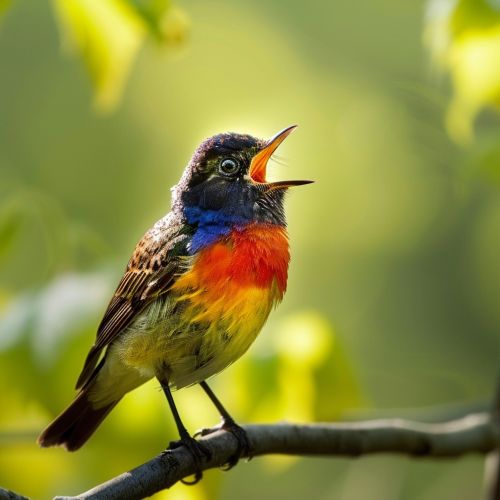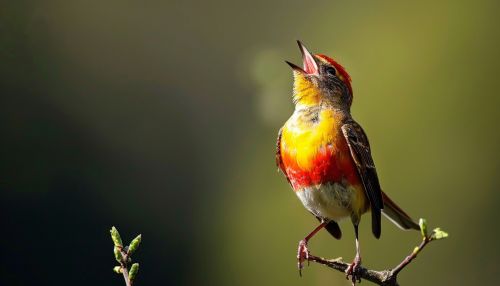Bird song: Difference between revisions
(Created page with "== Introduction == Bird song is a complex vocalization produced by birds, primarily by males, to communicate with other birds. These vocalizations play a crucial role in various behaviors, including mate attraction, territory defense, and signaling alarm. Bird song is distinguished from bird calls, which are typically shorter and serve different functions such as coordinating flock movements or signaling danger. == Anatomy of Bird Song Production == Bird song producti...") |
No edit summary |
||
| Line 7: | Line 7: | ||
Bird song production involves several specialized anatomical structures. The primary organ responsible for sound production in birds is the syrinx, located at the base of a bird's trachea. Unlike the human larynx, the syrinx allows birds to produce a wide range of sounds, often simultaneously. The complexity of the syrinx varies among species, contributing to the diversity of bird songs. | Bird song production involves several specialized anatomical structures. The primary organ responsible for sound production in birds is the syrinx, located at the base of a bird's trachea. Unlike the human larynx, the syrinx allows birds to produce a wide range of sounds, often simultaneously. The complexity of the syrinx varies among species, contributing to the diversity of bird songs. | ||
[[Image:Detail-92101.jpg|thumb|center|A colorful songbird perched on a branch, singing.|class=only_on_mobile]] | |||
[[Image:Detail-92102.jpg|thumb|center|A colorful songbird perched on a branch, singing.|class=only_on_desktop]] | |||
The respiratory system also plays a significant role in song production. Birds control the flow of air through the syrinx using their intercostal muscles and abdominal muscles. This precise control allows for the modulation of pitch and volume, essential for producing complex songs. | The respiratory system also plays a significant role in song production. Birds control the flow of air through the syrinx using their intercostal muscles and abdominal muscles. This precise control allows for the modulation of pitch and volume, essential for producing complex songs. | ||
Latest revision as of 05:01, 18 June 2024
Introduction
Bird song is a complex vocalization produced by birds, primarily by males, to communicate with other birds. These vocalizations play a crucial role in various behaviors, including mate attraction, territory defense, and signaling alarm. Bird song is distinguished from bird calls, which are typically shorter and serve different functions such as coordinating flock movements or signaling danger.
Anatomy of Bird Song Production
Bird song production involves several specialized anatomical structures. The primary organ responsible for sound production in birds is the syrinx, located at the base of a bird's trachea. Unlike the human larynx, the syrinx allows birds to produce a wide range of sounds, often simultaneously. The complexity of the syrinx varies among species, contributing to the diversity of bird songs.


The respiratory system also plays a significant role in song production. Birds control the flow of air through the syrinx using their intercostal muscles and abdominal muscles. This precise control allows for the modulation of pitch and volume, essential for producing complex songs.
Functions of Bird Song
Bird song serves several critical functions:
Mate Attraction
One of the primary functions of bird song is to attract mates. Male birds often sing elaborate songs to demonstrate their fitness to potential female partners. The complexity and duration of the song can indicate the health and genetic quality of the singer. In some species, females may also sing, although this is less common.
Territory Defense
Bird song is also used to establish and defend territories. By singing, a bird can communicate its presence and claim over a specific area to other males. This reduces the likelihood of physical confrontations, as the song serves as a deterrent to potential intruders.
Alarm Signaling
Birds use specific calls and songs to signal alarm and warn other birds of predators. These alarm calls are often sharp and repetitive, designed to be easily heard and recognized by other birds in the vicinity.
Learning and Development of Bird Song
Bird song is not entirely innate; it involves a learning process that varies among species. This process can be divided into several stages:
Sensory Phase
During the sensory phase, young birds listen to the songs of adult conspecifics. This phase is crucial for acquiring the song template that the bird will later reproduce. The duration of the sensory phase can vary, but it typically occurs during the early stages of a bird's life.
Sensorimotor Phase
In the sensorimotor phase, young birds begin to practice and refine their songs. This phase involves a significant amount of trial and error, as the bird attempts to match its vocalizations to the song template acquired during the sensory phase. This process is facilitated by auditory feedback, allowing the bird to adjust its song based on what it hears.
Crystallization
The final stage of song learning is crystallization, where the bird's song becomes stable and consistent. Once crystallized, the song remains relatively unchanged throughout the bird's life. However, some species exhibit song plasticity, allowing them to modify their songs in response to environmental changes or social interactions.
Neurobiology of Bird Song
The production and learning of bird song are controlled by specialized neural circuits in the brain. These circuits are collectively known as the song system and are divided into two main pathways: the motor pathway and the anterior forebrain pathway.
Motor Pathway
The motor pathway is responsible for the production of song. It includes the High Vocal Center (HVC) and the robust nucleus of the arcopallium (RA). Neurons in these areas send signals to the syrinx and respiratory muscles, coordinating the physical aspects of song production.
Anterior Forebrain Pathway
The anterior forebrain pathway is involved in song learning and plasticity. It includes the lateral magnocellular nucleus of the anterior nidopallium (LMAN) and Area X. This pathway is crucial for the acquisition and modification of song patterns, particularly during the sensorimotor phase.
Evolution of Bird Song
Bird song has evolved through a combination of natural and sexual selection. The diversity of bird songs across species is a result of various evolutionary pressures, including habitat, social structure, and mating systems.
Habitat Influence
The acoustic properties of a bird's habitat can influence the evolution of its song. For example, birds living in dense forests may produce lower-frequency songs that travel better through thick vegetation, while birds in open habitats may use higher-frequency songs that are less affected by wind and other environmental noise.
Social Structure
The social structure of a species can also impact song evolution. In species with complex social hierarchies, song complexity may be a critical factor in establishing dominance and social status. Conversely, in species with simpler social structures, song may play a more straightforward role in mate attraction and territory defense.
Mating Systems
Different mating systems can drive the evolution of bird song. In monogamous species, males may sing to maintain pair bonds and coordinate reproductive activities with their mates. In polygynous species, males may use elaborate songs to attract multiple females and compete with other males.
Cultural Transmission of Bird Song
Bird song can be culturally transmitted, meaning that song patterns can be passed from one generation to the next through learning rather than genetic inheritance. This cultural transmission can lead to the development of regional dialects, where populations of the same species exhibit distinct song patterns.
Dialects
Dialects are variations in song patterns that occur in different geographic regions. These dialects can arise due to limited dispersal of individuals, leading to isolated populations that develop unique song characteristics. Dialects can also result from social learning, where young birds adopt the songs of their local population.
Implications for Speciation
The development of dialects can have significant implications for speciation. If dialects become sufficiently distinct, they can contribute to reproductive isolation, where individuals from different populations no longer recognize each other's songs as conspecific. This reproductive isolation can eventually lead to the formation of new species.
Technological Advances in Bird Song Research
Recent technological advances have significantly enhanced our understanding of bird song. These technologies include bioacoustics, machine learning, and genetic analysis.
Bioacoustics
Bioacoustics involves the use of specialized equipment to record and analyze bird songs. High-quality microphones and recording devices allow researchers to capture detailed acoustic data, which can be analyzed to study song structure, frequency, and temporal patterns.
Machine Learning
Machine learning algorithms have become valuable tools in bird song research. These algorithms can process large datasets of bird songs, identifying patterns and classifying songs based on species, individual identity, and context. Machine learning has also been used to develop automated systems for monitoring bird populations and studying their behavior.
Genetic Analysis
Genetic analysis has provided insights into the heritability of song traits and the genetic basis of song learning. By studying the genomes of different bird species, researchers have identified genes associated with song production and learning. This genetic information can help elucidate the evolutionary mechanisms underlying bird song diversity.
Conservation Implications of Bird Song
Bird song research has important implications for conservation. Understanding the role of song in bird behavior and ecology can inform conservation strategies aimed at protecting endangered species and their habitats.
Habitat Preservation
Preserving habitats that support diverse bird populations is crucial for maintaining the acoustic environments necessary for effective communication. Habitat degradation can disrupt the transmission of bird songs, leading to reduced reproductive success and population declines.
Monitoring Populations
Bird song can be used as an indicator of population health and biodiversity. Acoustic monitoring programs can track changes in bird populations over time, providing valuable data for conservation efforts. These programs can also identify areas of high conservation priority based on the presence of rare or endangered species.
Mitigating Noise Pollution
Noise pollution from human activities can interfere with bird song communication. Conservation efforts can include measures to reduce noise pollution in critical habitats, such as implementing quiet zones and using noise barriers. These measures can help ensure that birds can effectively communicate and maintain their social and reproductive behaviors.
